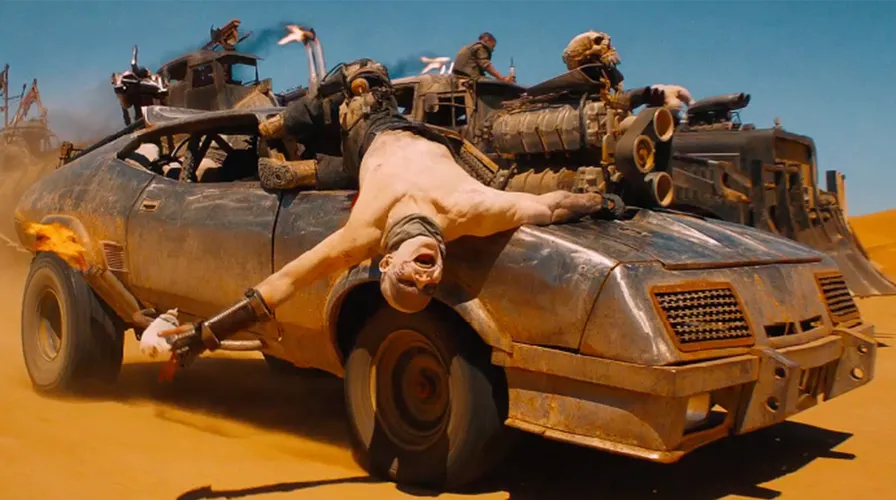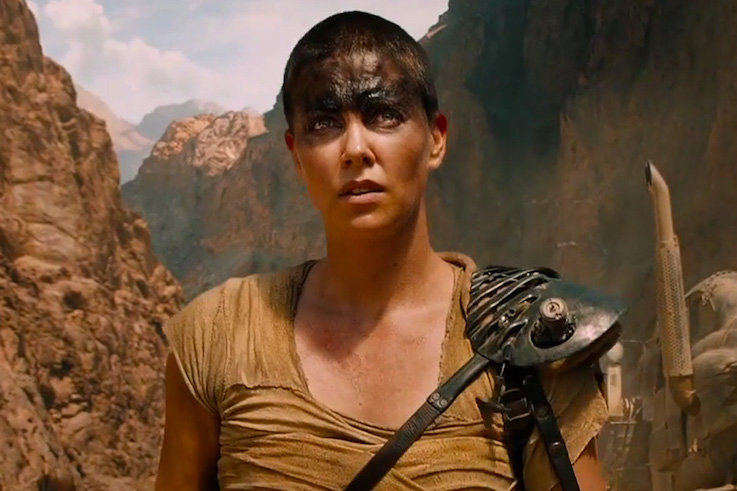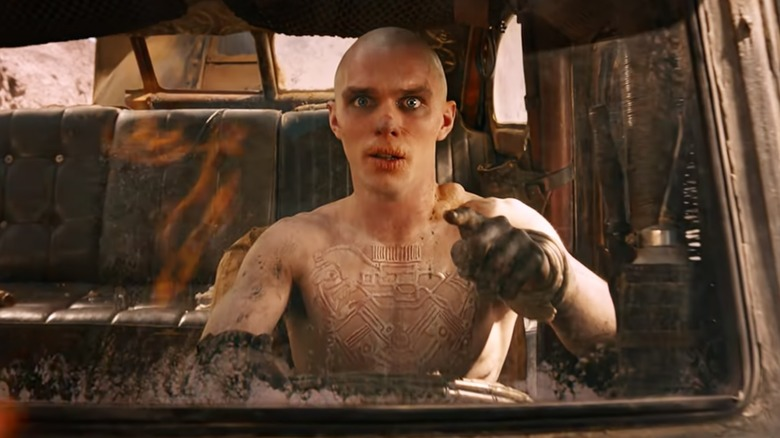With the impending release of Furiosa: A Mad Max Saga, now seems as good a time as any to revisit George Miller’s modern classic, Mad Max: Fury Road. Swapping Mel Gibson for Tom Hardy in the titular role, Fury Road became a critical darling, raking in ten Oscar nominations and becoming one of the defining films of 2015, the 2010s, and the action genre as a whole. But it’s a small miracle this movie even exists. Let’s dive into the troubled production of the film and witness how it rose from development hell into production hell to riding eternal, shiny and chrome.
The premise for Mad Mad: Fury Road is a simple one on paper, but filled with more nuance and depth than you’d think. While out in the Wasteland, Max is captured by the War Boys of Immorten Joe, a local warlord who elects to keep Max as a mobile blood bag for his troops. At the same time, Furiosa (Charlize Theron) leaves the Citadel fortress with a war party en route to Gas Town in a giant tanker known as the War Rig. But Furiosa has plans of her own and is actually in the midst of betraying the warlord by smuggling his many brides away from his vile clutches and escaping to Furiosa’s childhood home called “The Green Place”. Joe catches on quick to Furiosa’s plan when she diverts from the route and sends a whole war party after her, which includes Max tied up to the hood of a car. After an epic car chase, concluding by driving into a sandstorm, Max finds himself assisting Furiosa and the brides to get to the sanctuary. Of course, the Green Place she once knew is gone and with Joe’s entire force out hunting them, they opt to make a mad dash to the unprotected fortress in a last-effort attempt to overthrow him and build a better place in the hellhole that is the Wasteland.

And that’s it. That’s the movie. You may be wondering, what’s the big deal with this movie if its narrative is so simple? The answer is simple: George Miller’s direction. This is a movie that seemingly defies convention and in all honestly, it’s amazing no one died during the troubled production. But in the end, Miller was able to finish the film without anyone dying or getting seriously hurt, apart from the egos of the two leads that is.

To say Mad Max: Fury Road had a long and troubled development would be an understatement. Miller came up with the idea of Max’s next movie involving one single chase sequence all the way back in 1987, a couple of years after the release of the third film in the franchise, Mad Max: Beyond Thunderdome. It would remain simply an idea until 2000, when pre-production finally got underway, with Mel Gibson set to return as Max Rockatansky and Sigourney Weaver and Uma Thurman in-talks to take on the role of Furiosa. But despite the pieces falling into place, the movie was put on indefinite hiatus after the September 11th terrorist attacks, in part because the American dollar crashed against the Australian dollar, which is a problem as the film was being produced by the Aussies. With the film set to film in Namibia, security concerns arose in the following American wars in the Middle East. Then, with Gibson aging out of the role in combination with his infamous controversial outbursts, forced Miller to put the would-be Fury Road on the back-burner as he focused on Happy Feet instead.

George Miller then flirted with the idea of turning his Fury Road concept into an anime-inspired feature film, with Gibson back in the lead role lending his voice. This would coincide with the release of a Mad Max video game made with God of War’s Cory Balrog and while the animated film would never see the light of day, the video game concept would eventually evolve and ultimately release, without Balrog, as the 2015 video game Mad Max, which is an awesome game. But Miller ultimately thought animation would be a disservice to Mad Max and reverted to live-action, with Tom Hardy officially being cast as Max in 2010 and principal production began in 2012 in the original Namibian filming location Miller wanted, taking the production away from Australia for the first time.

To say the production was nightmarish would be an understatement. In this production, Fury Road was to be shot in Broken Hill, Australia despite his initial plans, but an intense bout of rain and flooding actually caused the dusty filming location where Miller filmed the first two films to grow vegetation. So the studio opted to revert to the original plan of filming in Namibia after a year of waiting to see if the dusty mining town would become derelict again. It’s here where it was accused of harming the desert and its ecosystem (an accusation that was ultimately proved to be “unjust”. And despite shooting in the Namibian desert, production was over their winter, so shoots could get quite cold, with hypothermia being reported on the night shoots and reports that George Miller himself appeared to be deteriorating.
Then there was the beef between the two leads. Hardy and Theron despised each other, which caused production problems. Hardy was hired for his brilliance as an actor, stated Miller, but would often show up to set late and delayed the shoot for everyone else, whereas Theron would arrive promptly on time without fail, to the point where producer Denise Di Nova had to be flown to the production to oversee the two stars who began clashing on set.

Miller was hoping that the on-set animosity would result in better performances but would later state: “There’s no excuse for it. I think there’s a tendency in this business to use great performances as an excuse for other disruption that could be avoided.” Hardy would state that he was “in over my head in many ways. The pressure on both of us was overwhelming at times. What she [Theron] needed was a better, perhaps more experienced partner in me. That’s something that can’t be faked. I’d like to think that now that I’m older and uglier, I could rise to that occasion.” Theron had this to say about George Miller’s mindset during filming: “I think he didn’t want any interference, and there were several weeks on that movie where I wouldn’t know what was going to come my way, and that’s not necessarily a nice thing to feel when you’re on your job. It was a little bit like walking on thin ice.”
While filming took place in 2012 and initially wrapped in that same year, the production had to be picked up again in 2013 (this time in Australia) for extensive reshoots that lasted almost three months for scenes involving the Citadel. The overall production was so hellish for Miller that in 2016, after the release of Fury Road, he vowed never to film another Mad Max movie again. We all know he changed his mind on that statement.

Fury Road stood out to many for its commitment to practical effects. There’s still a ton of movie magic going on here, such as when the oil rig blows up being surrounded by a convoy of cars (this is actually two shots layered on top of each other), but Miller stated that roughly 90% of the film was achieved via practical effects. And it shows. Fury Road is visceral and kinetic in a way that could only have been achieved with practical effects and it’s a small miracle no one died while making this movie. Bear in mind this movie was shot in the middle of a barren desert! In a decade and genre that was being overtaken by rampant use of CGI, such as the Marvel films, Jurassic World and Terminator (all 2015 releases, I should add), Fury Road’s commitment to practicality was not only welcome but awe-inspiring. How did he achieve those camera shots, how did that stunt performer do that shot? Those were questions that infected the audiences’ minds as they watched the spectacle. Some of the stunts, featuring pole cats, were even inspired by Cirque du Soleil, and Miller and supervising stunt coordinator Guy Norris even hired a Soleil performer to train their stun team. Hardy would later state that Fury Road was Cirque du Soleil meets the metal band Slipknot and a more accurate description, there is not.
For post-production, composer Junkie XL was brought in for the score and Miller and his editor wife Margaret Sixel opted to bring the framerate down from 24 frames for around half of the film, to allow the audience to see the action with better clarity. When George Miller agreed to do the film for Warner Bros, they made it conditional that the film would be PG-13 (much like Beyond Thunderdome) to get a wider box office result. But Miller and Sixel drafted two cuts of the film, one at PG-13 as mandated and one R-rated cut that Miller felt was the better version. After testing both versions with test audiences, the “Miller Cut” scored much better and Warner Bros wisely pivoted direction, electing to make Fury Road a hard R film (and the prequel Furiosa: A Mad Max Saga got the same rating as well).
Despite still using digital VFX and digital trickery, the promise of a practically shot film helped create ample buzz for Mad Max: Fury Road. But on top of all that, the movie ended up being a smash hit with both critics and fans, earning ten Oscar nominations at the 2016 award ceremony and winning six, the most of the night; something Miller and his team were not expecting when making the movie. Despite being a film about maniacs engaging in car warfare in the wasteland, the film had strong themes of feminism and free will acting as the foundations for the plot, with Furiosa smuggling out the imprisoned wives of the villainous Immorten Joe from his Citadel. Plastered upon the walls of their former “home”, the wives left messages such as “we are not things”, “our babies will not be warlords”, and “who destroyed the world?”. In the end, Fury Road is a film that ends up being more about taking down the patriarchy than Barbie was (arguably).

Between the decades-long conception, and a gruelling and dangerous shoot made more tedious thanks to a feud between the two leads, it’s honestly amazing Fury Road came out as iconic as it is. It’s one of, if not the, best action films of the 2010s and of the century to date. It’s memorable, distinct, and outrageous, but layered with nuance and depth. Now, Miller returns to the Wasteland for the story of Theron’s Furiosa, with Anya Taylor-Joy taking over in the prequel and there’s even talks of a new Mad Max film being developed. I haven’t even seen Furiosa yet but I’m already ready to follow Miller back into the Wasteland.
Sources
‘Mad Max: Fury Road’: The Oral History of a Modern Action Classic
The Mad Max Movies. Martin, Adrian. (2003)

2 thoughts on “The Nightmare Production That Was ‘Mad Max: Fury Road’ – ScreenHub Entertainment”